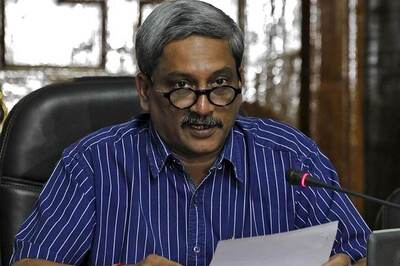
views
Narendra Modi became the first Indian Prime Minister to visit Poland in 45 years in August 2024, marking a historic moment for both countries (Poland and India) and two continents (Europe and Asia). This visit was significant in many ways. The Kolhapur Memorial in Warsaw clearly demonstrates the longstanding friendship between India and Poland. The city of Kolhapur in Maharashtra provided refuge to the Polish people during the Second World War, in a camp established at Valivade. This settlement housed approximately 5,000 Polish refugees, including women and children. The Kolhapur Memorial in Warsaw thus highlights a special historical connection between India and Poland, one that continues to be nurtured and strengthened.
Additionally, PM Modi’s historic visit to Ukraine in August 2024 was the first by an Indian leader to Kyiv since the countries established bilateral relations over 30 years ago. All of these landmark visits by Modi occurred within the first 100 days of his third consecutive term.
In the meantime, India and the US have forged closer ties than ever before. The US Secretary of Defense, Lloyd Austin, recently highlighted the countries’ growing defence cooperation, including efforts to strengthen critical supply chains and improve interoperability between their militaries. “We share a vision of a free and open Indo-Pacific, and our defence cooperation continues to grow stronger and stronger,” Austin said in a recent news release. “We’re expanding our defence industrial ties, working to co-produce more capabilities, and strengthening supply chain resilience,” he added.
India’s participation in the recent Rim of the Pacific military exercise, led by the US Navy in Hawaii, which brought together 29 partner nations, is yet another example of PM Modi’s formidable stature. “The Indian Navy remains an important security provider in the Indian Ocean,” Austin said, emphasising the US commitment to deepening naval cooperation, enhancing the use of unmanned technology, and strengthening undersea domain awareness. Clearly, Modi 3.0 has taken significant strides in expanding India’s diplomatic heft within the first 100 days of his third term in office.
Additionally, earlier this month, India and Singapore elevated their ties to a comprehensive strategic partnership by covering newer areas such as advanced manufacturing, digitisation and connectivity. The visit came after the conclusion of the second India and Singapore Ministerial Roundtable, which expanded the pillars of bilateral cooperation and laid the groundwork for the four new landmark Memorandums of Understanding (MoUs). India and Brunei also elevated their ties to an enhanced partnership on September 3, 2024, and agreed to cooperate in trade, investment, energy, space, education and cultural exchanges. The two countries agreed to leverage the bilateral Joint Trade Committee, given the potential to tap into the China plus-one strategy. With India’s priority to strengthen energy security and increase domestic gas consumption, the two sides committed to exploring a long-term liquefied natural gas contract. Other notable developments included the inauguration of a new chancery of the Indian High Commission, the creation of a defence cooperation working group and the signing of a new space cooperation pact.
The India-Singapore joint statement reiterated the importance of peace, stability, and freedom of navigation in the South China Sea, while supporting the right of Quadrilateral Security Dialogue (Quad) members—India, Australia, Japan, and the United States—to remain active in the Indo-Pacific. This underlines the growing bilateral cooperation in the shipping channel between the Strait of Malacca and the Andaman Sea. With Brunei, India agreed to strengthen cooperation in the space sector, including satellite development, and remote sensing and training. With Singapore companies committing to invest $60 billion in India in the next few years, businesses can expect to see new opportunities across semiconductors, digital technologies, energy and sustainability, health care, logistics, infrastructure and manufacturing. With Brunei, oil, gas, and space will likely be important facets of relations, given that Brunei is one of the largest energy producers in the region and India’s energy demand is expected to grow 6-6.5 per cent annually.
While expanding India’s growing foreign policy clout in his first 100 days in office has been a highly notable achievement of PM Modi, there are many other feathers in his cap. The major aim of Modi 3.0 in the first 100 days was to steer the nation towards the vision of Viksit Bharat. In just 100 days, Rs 15 lakh crore has been invested in infrastructure, agriculture, women’s development, and the upliftment of Scheduled Tribes (ST), Scheduled Castes (SC), Other Backward Classes (OBC), and the poor. Significant progress has been made in the development of agriculture, rural areas, highways, railways, air connectivity, and ports. In particular, Rs 3 lakh crore has been invested in infrastructure during these 100 days, with a special focus on the agricultural sector.
Capital expenditure has been increased to Rs 11.11 lakh crore, providing a boost to employment generation. The Minimum Support Price (MSP) has been increased by between 5 per cent and 12.7 per cent. Additionally, Rs 20,000 crore from the 17th instalment of the PM-Kisan scheme has been disbursed to 9.3 crore farmers. Furthermore, three crore houses have been sanctioned for women across the country, empowering them during these first 100 days. In Tamil Nadu, two Vande Bharat trains have been sanctioned and inaugurated by Prime Minister Modi, one from Chennai to Nagercoil and another from Madurai to Bangalore. In the past 100 days, 15 Vande Bharat Express trains have been flagged off, and eight new railway line projects have been cleared.
In Tuticorin, a new terminal port has received an investment of Rs 7000 crore as part of the 100-day plan and 11 new cities have been covered under the FM channel expansion. In the fisheries sector, new aqua parks are being established. These achievements in just 100 days highlight the government’s commitment to rapid development across sectors, with a focus on empowering all sections of society. Under the Lakhpati Didi Yojana, 11 lakh new women have been added in just 100 days. One crore women are now earning over Rs 1 lakh annually, enabling them to lead their lives with dignity and respect.
The biggest achievement of Prime Minister Modi is that he has brought about an environment of political stability in the country. We have witnessed the execution of policies in line with Modi’s grand vision. PM Modi introduced the New Education Policy in 2020 and has further strengthened it in the last 100 days of Modi 3.0. The approval of infrastructure projects worth Rs 3 lakh crore, including linking 25,000 unconnected villages to road networks and building a mega port at Vadhavan in Maharashtra during these first 100 days, are transformational steps.
Beyond infrastructure, Modi 3.0 has also focused on agriculture by increasing the Minimum Support Price (MSP) for Kharif crops, removing the Minimum Export Price (MEP) on onions and basmati rice, and raising the duty on the import of crude palm, soybean, and sunflower oils. The Vadhavan Mega Port in Maharashtra, costing Rs 76,200 crore, will rank among the top 10 ports in the world. Under the Prime Minister’s Rural Roads Scheme-4 (PMGSY-IV), approval has been granted for the construction and upgrading of 62,500 km of roads and bridges to connect 25,000 unconnected villages, with central assistance of Rs 49,000 crore. Many of these unconnected villages have populations of fewer than 100.
The Modi government has also approved the strengthening of India’s road network with an investment of Rs 50,600 crore. This includes the approval of eight National High-Speed Road Corridor Projects covering 936 km and the development of 12 industrial “Smart Cities”. The foundation stone for the Shinkhun-La Tunnel, which will link Ladakh and Himachal Pradesh, has also been laid. Additionally, eight new railway lines have been sanctioned, creating 4.42 crore man-days of employment. The Lal Bahadur Shastri International Airport in Varanasi is set for development, while new civil enclaves at Bagdogra in West Bengal and Bihta in Bihar have been approved. Airstrips in Agatti and Minicoy in Lakshadweep have also received approval, along with expansion plans for the Bangalore Metro (Phase 3), Pune Metro, and Thane Integral Ring Metro Rail Project. The Polavaram Irrigation Project in Andhra Pradesh has been allocated Rs 12,100 crore in funding, while seven major schemes have been launched under the Digital Krishi Mission, with a total allocation of Rs 14,200 crore.
Other initiatives include drafting a new National Cooperative Policy, scrapping the Minimum Export Price (MEP) on onions and Basmati rice, reducing the export duty on onions from 40 per cent to 20 per cent, approving a Rs 2,000 crore ‘Mission Mausam’ to build climate resilience, and launching a new fund named Agrisure aimed at revolutionising the agricultural sector. Supporting startups and rural enterprises has also been formalised. According to government data, over Rs 3.2 lakh crore has been distributed to more than 10 crore farmers via PM-Kisan. Additionally, the hike in Minimum Support Price (MSP) for Kharif crops in 2024-25 will benefit around 12 crore farmers, providing an additional Rs 2 lakh crore. ‘Mission Mausam’, which will allocate Rs 2,000 crore to improving weather forecasts and other interventions, will also benefit farmers.
The Modi government in its first 100 days also installed solar energy systems in over 2.5 lakh homes. Modi 3.0 abolished the 31 per cent angel tax, which had burdened startups since 2012. Additionally, a Rs 1000 crore venture capital fund was established for space sector startups. MUDRA loan limit was increased from Rs 10 lakh to Rs 20 lakh, a credit guarantee scheme for MSMEs was launched to provide collateral-free loans and e-commerce export hubs for traditional artisans were announced too.
The Modi government in its third term also introduced three new laws — Bharatiya Nyay Sanhita, Bharatiya Nagarik Suraksha Sanhita, and Bharatiya Sakshya Adhiniyam—to replace outdated colonial criminal laws. The National Forensic Infrastructure Enhancement Scheme (NFIES) was approved, with a budget of Rs 2254 crore over five years (2024-29) to improve the criminal justice system. A package of Rs 2 lakh crore was approved to increase youth employment and skill development during the full Budget for FY25, with the government targeting one crore youth for internships at top Indian companies. For first-time employees under the EPFO, the government will provide an incentive of up to Rs 15,000 in three installments. For women, the Modi government allocated Rs 2500 crore to the Community Investment Fund to support 48 lakh members of 4.3 lakh Self Help Groups. Expanding the Ayushman Bharat Scheme, Modi 3.0 recently announced free insurance of up to Rs 5 lakh to citizens above 70 years of age. Customs duty exemptions were also granted for vital cancer medications. Permission has been granted to open 113 new medical colleges, which will not only strengthen the medical infrastructure but also increase the number of MBBS seats.
The Public Examinations (Prevention of Unfair Means) Act 2024, aimed at curbing paper leaks, malpractices, and organised fraud in recruitment examinations such as UPSC, SSC, and entrance tests like NEET, JEE, and CUET, is designed to safeguard the merit of our youth and protect the well-being of students. It targets corrupt practices by unscrupulous individuals that jeopardise the future of young people, destroying their careers and aspirations. Over the last ten years, the Modi government has introduced youth-centric provisions and schemes to ensure transparency, equal opportunities, and a level playing field in recruitment and higher education. This Act further strengthens those efforts.
The most sweeping reform in the first 100 days of Modi 3.0 has been the much-touted pension reform known as the Unified Pension Scheme (UPS). UPS shifts the responsibility for funding pensions away from employees. Under this scheme, employees are entitled to receive 50 per cent of their average basic pay from the last 12 months before retirement as their pension. In the unfortunate event of an employee’s death before retirement, 60 per cent of the pension is provided to the spouse. For employees with shorter service periods, UPS guarantees a minimum pension of Rs 10,000 per month. The scheme also includes inflation indexation, similar to Dearness Allowance (DA), to adjust the assured pension, family pension, and minimum pension according to inflation rates. Additionally, UPS provides a lump sum payment at retirement. Employees receive one-tenth of their monthly salary (pay + DA) as a one-time payment for every six months of service, in addition to the gratuity amount. In many ways, the UPS combines the best features of both the Old Pension Scheme (OPS) and the New Pension Scheme (NPS), marking a landmark reform by the Modi government, implemented within the first 100 days of PM Modi’s tenure.
Speaking of economic heft, one of the biggest achievements is that India has now become the world’s second-largest mobile producer. A new semiconductor unit will soon be established in Sanand, Gujarat. Around Rs 3300 crore will be invested in this and it will have a production capacity of around 6 million chips per day. In an effort to make India better prepared for natural disasters, a national database has been created and for the purpose of maintaining rural land records, the Bhuvan Panchayat portal has been established by the Modi government.
In terms of science and space, the first National Space Day was celebrated on August 23, 2024, to honour the success of Chandrayaan and Mangalyaan. A Rs 1000 crore venture capital fund scheme has been established to strengthen space startups. A National Research Fund of Rs 50,000 crore has been set up. The Vigyan Dhara scheme has also been established with a budget of Rs 10,500 crore. Apart from all these measures, the Modi Cabinet has approved the Venus Orbiter Mission, the expansion of Gaganyaan and Chandrayaan-4 missions. The Union Cabinet also approved the development of India’s first space station and NextGen launch vehicles.
Clearly, if the first 100 days are anything to go by, Modi 3.0 is poised to be a game changer in propelling India onto the path of higher growth, equity, structural reforms, and macroeconomic stability. Beyond all this, it aims to usher in a climate of endless opportunities where merit and inclusivity are embraced, in the true spirit of Sabka Saath, Sabka Vikas, Sabka Vishwas, and Sabka Prayas.
Sanju Verma is an Economist, National Spokesperson of the BJP and the Bestselling Author of ‘The Modi Gambit’. Views expressed in the above piece are personal and solely those of the author. They do not necessarily reflect News18’s views.


















Comments
0 comment